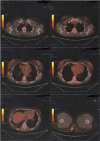Sarcoidosis mimicking metastatic progression of pancreatic neuroendocrine tumor: A case report
- PMID: 28658123
- PMCID: PMC5500045
- DOI: 10.1097/MD.0000000000007273
Sarcoidosis mimicking metastatic progression of pancreatic neuroendocrine tumor: A case report
Abstract
Rationale: Pancreatic neuroendocrine tumors (PNETs) account for less than 5% of all pancreatic tumors. PNETs develop from pancreatic endocrine islet cells and have a variable range of malignant potential. These neoplasms tend to have a slower growth rate than exocrine tumors and may remain undetectable for years. Achieving a correct diagnosis and staging is of key importance for the optimal management of the disease and requires experience with the disease, an accurate clinical status evaluation and a critical interpretation of the radiological findings derived from morphological and functional imaging techniques as well as an integrated multidisciplinary approach. The possibility that some clinical data and radiological findings encountered during the diagnostic and staging procedures may not be related to PNETs but to concomitant clinical conditions should always be taken into consideration. This is mandatory as an incorrect stadiation may lead to patients' mis-management.
Patient concerns: We report the case of a 34-year-old female, with a past medical history of idiopathic acute pancreatitis, presenting with a severe upper abdominal pain, steady and radiating to the back.
Diagnoses: Initial investigations incidentally detected a nonfunctioning pancreatic neuroendocrine tumor (NF-PNET) of intermediate grade G2. Subsequent investigations aimed at determining a correct tumor staging showed a negative indium-111- OctreoScan but an increased 18F-labeled fluorodesossiglucose (18F-FDG) uptake in multiple bilateral nodules in the lungs and in 1 nodular lesion located in the right gluteal subcutaneous tissue. An early tumor progression of a G2 NF-PNET that had to be treated with chemotherapy was suspected.
Interventions: The histological examination of the gluteal subcutaneous nodule showed noncaseating granulomas, disproving the initial clinical suspect and allowing the diagnosis of active sarcoidosis in the G2 NF-PNET patient.
Lessons: A misdiagnosis and a consequent therapeutic mismanagement were avoided with the support of an integrated multidisciplinary team.
Conflict of interest statement
The authors have no funding and conflicts of interest to disclose.
Figures




References
-
- Klimstra DS. Pathology reporting of neuroendocrine tumors: essential elements for accurate diagnosis, classification, and staging. Semin Oncol 2013;40:23–36. - PubMed
-
- Squires MH, 3rd, Volkan Adsay N, Schuster DM, et al. Octreoscan versus FDG-PET for neuroendocrine tumor staging: a biological approach. Ann Surg Oncol 2015;22:2295–301. - PubMed
-
- Iannuzzi M, Fontana JR. Sarcoidosis: clinical presentation, immunopathogenesis, and therapeutics. JAMA 2011;305:391–9. - PubMed
-
- Mostard RL, van Kroonenburgh MJ, Drent M. The role of the PET scan in the management of sarcoidosis. Curr Opin Pulm Med 2013;19:538–44. - PubMed
Publication types
MeSH terms
Supplementary concepts
LinkOut - more resources
Full Text Sources
Other Literature Sources
Medical
Miscellaneous

